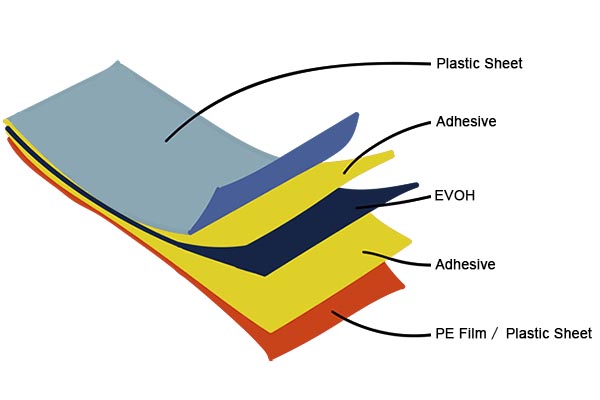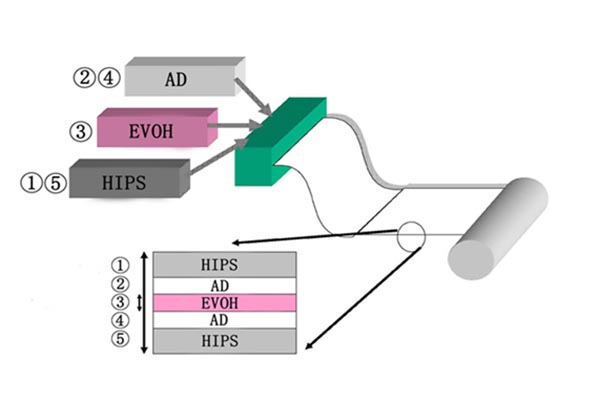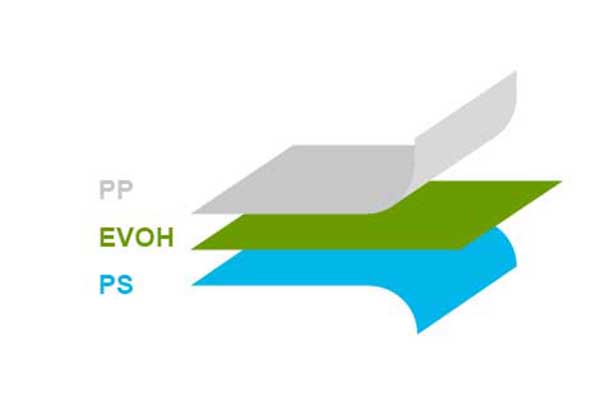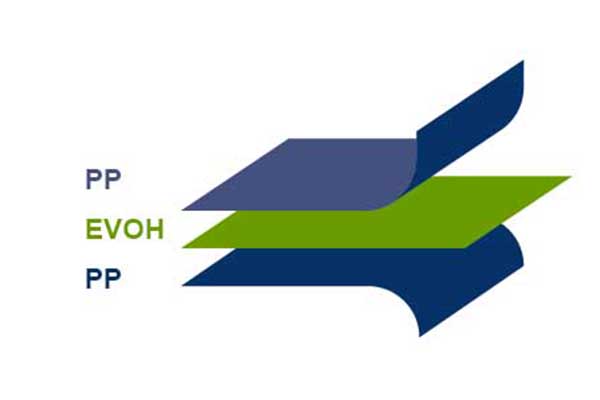Ethylene-vinyl alcohol copolymer, referred to as EVOH, is known as the world’s three largest barrier resins together with polyvinylidene chloride (PVDC) and polyamide (PA). EVOH can greatly inhibit the intrusion of oxygen in the air into food, thereby inhibiting the production of toxins and other harmful substances due to the proliferation of microorganisms, and can also prevent composition changes caused by oxidation, while maintaining fragrance and preventing external odor pollution. Moreover, the lack of moisture barrier properties can be compensated by other polyolefin layers.
Therefore, EVOH multi-layer composite plastic sheet packaging material can effectively prevent food spoilage and prolong shelf life. In addition, it is easy to process and form, and has good environmental protection performance. Due to the excellent gas barrier properties, transparency, processability and solvent resistance of EVOH resin, its application fields are getting wider and wider, and the demand is also growing rapidly.
EVOH has been the most widely used high-barrier material. In addition to the non-stretching type, the film types of this material include biaxially oriented, aluminum vapor deposition, and adhesive-coated types. Among the biaxially oriented types, there are heat-resistant types for aseptic packaging products. The barrier properties of EVOH depend on the ethylene content. Generally speaking, when the ethylene content increases, the gas barrier properties decrease, but it is easy to process.
Advantages of EVOH:
The remarkable feature of EVOH is that it has excellent gas barrier properties and excellent processability. In addition, it has excellent transparency, gloss, mechanical strength, stretchability, abrasion resistance, cold resistance and surface strength.
In the field of packaging, EVOH is made into a composite film intermediate barrier, which is used in all rigid and flexible packaging. In the food industry it is used in aseptic packaging, hot cans and retort pouches, packaging of dairy products, meat, canned juices and condiments. In terms of non-food products, it is used for packaging solvents, pesticide chemicals, air-conditioning structural parts, gasoline drum linings, electronic components, etc.
In terms of food packaging, EVOH’s plastic containers can completely replace glass and metal containers. Many domestic aquatic companies use PE/EVOH/PA/RVOH/PE five-layer co-extrusion film vacuum packaging for exporting seafood. While accelerating the research of EVOH composite film, the stretching orientation of EVOH is also being studied abroad. The gas barrier performance of the new EVOH film is 3 times that of the existing high-performance non-stretch EVOH film.
In addition, EVOH can also be used as a barrier material to coat other synthetic resin packaging materials to enhance the barrier performance.
EVOH multi-layer co-extrusion composite plastic sheet:
When EVOH is used as a high barrier material, it usually adopts a multi-layer composite structure. Commonly used composite materials are: PP, HIPS, PE, EVOH, AD, and AD is the adhesive in the structure.






Features of multi-layer co-extruded composite sheet:
(1) The stability of the barrier layer can be improved by replacing the single-layer polymer with multiple layers of the same polymer in the barrier layer.
(2) When it is confirmed that the set thickness of the barrier layer is sufficient to meet the barrier requirements, replacing the single-layer polymer with multiple layers of the same polymer in the barrier layer can reduce the cost of high value-added raw materials for the barrier film.
(3) Substituting two different polymers for a single type of polymer in the barrier layer can significantly improve the barrier properties of the film. For example, combining the EVOH layer with the PA layer can not only maintain the puncture resistance of the PA, but also increase the strength of the EVOH and improve the crack resistance of the EVOH because the EVOH layer is sandwiched in the middle of the PE layer. For a five-layer structure, two different barrier layers should be used at the same time, and one of them can only be on the outermost layer. The method of thickness compensates, resulting in an increase in cost.
(4) Divide the heat-sealing layer and the composite layer into two groups, one of which replaces the higher-priced polymer with a cheaper polymer to reduce the cost of the film while maintaining the strength of the film. Another group uses functional polymers that meet their functional requirements. Use the multi-layer concept to make more economical composite films. For example, comparing two one-kilogram films, the five-layer structure requires about 19% more material than the seven-layer structure.
(5) The use of co-extruded films with more layers can improve the performance of PA co-extruded films with less than five layers. For example, the use of an additional adhesive layer can improve the barrier properties of the film by increasing the water vapor barrier of the film. Another advantage obtained at the same time is that the film can be made softer and feel better.
(6) The use of co-extruded films with more layers can improve the stress warpage resistance of PA co-extruded films with less than five layers. At the same time, it meets the needs of secondary processing such as bag making.
(7) It integrates other functions of the dry-type composite film except the inner printing, which simplifies the composite process, the composite structure tends to be flexible, the functions tend to be diversified, the cost is significantly reduced, and it is safer, more hygienic and environmentally friendly. requirements, social and economic benefits are more significant.
